The Automotive Hydrostatic Fan Drive System Market is estimated to be valued at USD 11.1 billion in 2025 and is projected to reach USD 23.6 billion by 2035, registering a compound annual growth rate (CAGR) of 7.8% over the forecast period.
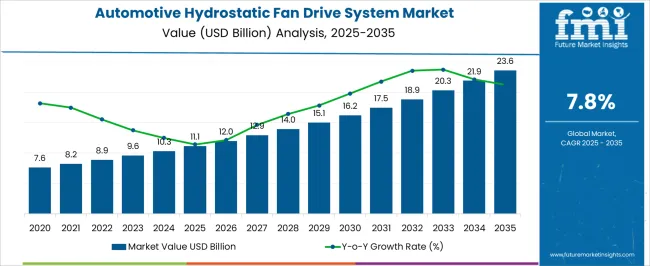
| Metric | Value |
|---|---|
| Automotive Hydrostatic Fan Drive System Market Estimated Value in (2025 E) | USD 11.1 billion |
| Automotive Hydrostatic Fan Drive System Market Forecast Value in (2035 F) | USD 23.6 billion |
| Forecast CAGR (2025 to 2035) | 7.8% |
The Automotive Hydrostatic Fan Drive System market is witnessing steady growth driven by the increasing demand for fuel-efficient and thermally optimized engine cooling solutions. In 2025, the market is being influenced by the adoption of advanced hydrostatic fan drives in both passenger and commercial vehicles, where precise temperature control is critical for engine performance and emissions compliance.
The integration of intelligent control systems and variable displacement pumps is enabling better cooling efficiency while minimizing energy consumption, thereby reducing operational costs. Growth is also being supported by stricter emission standards, increasing vehicle electrification trends, and rising awareness of vehicle reliability and maintenance optimization.
The ability of hydrostatic fan drives to adjust fan speed dynamically according to engine load and environmental conditions is contributing to broader adoption Furthermore, the market is anticipated to benefit from ongoing innovations in pump technology, control modules, and integration with overall vehicle powertrain management systems, ensuring enhanced engine longevity and performance across diverse automotive applications.
The automotive hydrostatic fan drive system market is segmented by type of vehicle, component, pump type, and geographic regions. By type of vehicle, automotive hydrostatic fan drive system market is divided into On Road Vehicles, Off Road Vehicles, Construction & Mining Equipment, Agricultural Vehicles, and Train, Metro, and Trams. In terms of component, automotive hydrostatic fan drive system market is classified into Engine Control Unit (ECU), Variable Axial Piston Hydraulic Pump, Fixed Gear Hydraulic Motor, Hydraulic Valves & Sensors, and Oil Cooler. Based on pump type, automotive hydrostatic fan drive system market is segmented into Variable Displacement Pump and Fixed Displacement Pump. Regionally, the automotive hydrostatic fan drive system industry is classified into North America, Latin America, Western Europe, Eastern Europe, Balkan & Baltic Countries, Russia & Belarus, Central Asia, East Asia, South Asia & Pacific, and the Middle East & Africa.
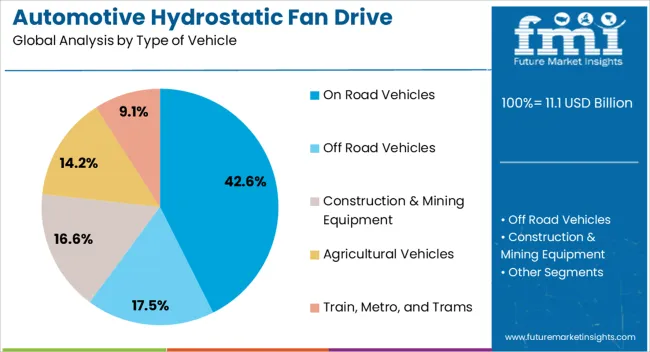
The On Road Vehicles segment is projected to hold 42.60% of the Automotive Hydrostatic Fan Drive System market revenue in 2025, making it the leading vehicle type. This dominance is being driven by the widespread adoption of hydrostatic fan drives in passenger cars, light trucks, and buses where efficient engine cooling is critical for meeting fuel efficiency and emissions standards. Adoption has been accelerated by increasing urban mobility and regulatory requirements for thermal management in commercial fleets.
On road vehicles benefit from the ability to integrate hydrostatic fan drives with engine management systems, allowing dynamic adjustment of fan speed according to operating conditions. The reliability and durability of these systems in high-traffic, stop-and-go environments have further encouraged their adoption.
Additionally, reduced parasitic losses and lower noise levels offered by hydrostatic systems have enhanced passenger comfort while improving overall vehicle performance The segment is expected to maintain leadership as vehicle manufacturers increasingly prioritize fuel economy, emission compliance, and engine longevity through advanced fan drive solutions.
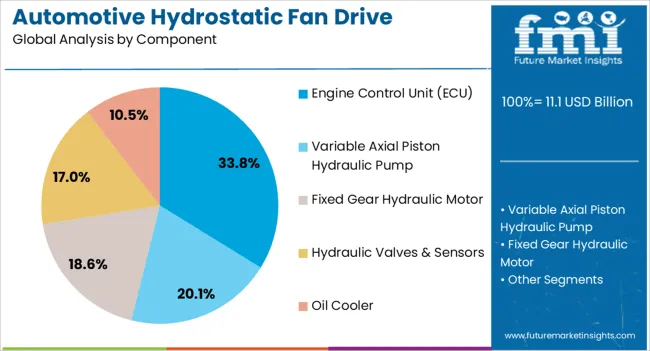
The Engine Control Unit segment is anticipated to account for 33.80% of the component revenue share in 2025, emerging as the largest contributor within the Automotive Hydrostatic Fan Drive System market. Growth in this segment has been driven by the critical role of control units in regulating fan speed based on engine temperature, vehicle load, and environmental conditions.
Adoption is being supported by advancements in electronic control systems that allow precise modulation of fan operation, resulting in enhanced fuel efficiency, reduced emissions, and improved engine performance. The integration of ECUs with vehicle telematics and diagnostics systems has increased predictive maintenance capabilities, thereby reducing downtime and operational costs.
Furthermore, the modular design of modern ECUs facilitates compatibility across multiple vehicle platforms, increasing scalability for manufacturers As emission norms become stricter and vehicle thermal management becomes increasingly complex, the demand for sophisticated engine control units in hydrostatic fan drive systems is expected to continue its upward trajectory, reinforcing the segment’s leadership position in the market.
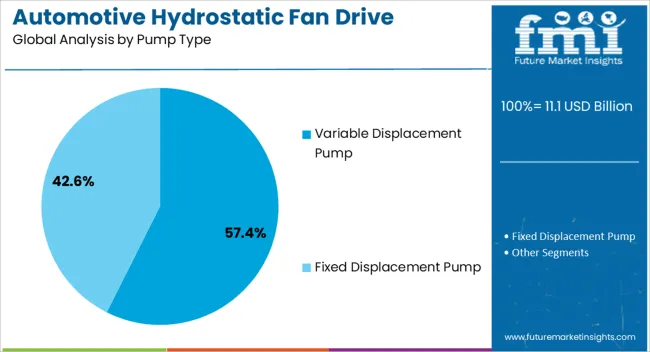
The Variable Displacement Pump segment is projected to capture 57.40% of the pump type revenue share in 2025, establishing it as the leading pump technology within the Automotive Hydrostatic Fan Drive System market. This dominance is being driven by the pump’s ability to modulate flow rates dynamically, ensuring optimal engine cooling while minimizing energy consumption. Adoption has been accelerated in applications where precise thermal control is critical, such as high-performance engines and vehicles operating in varying environmental conditions.
The efficiency gains provided by variable displacement pumps reduce parasitic power loss, contributing to improved fuel economy and reduced carbon emissions. Furthermore, the compatibility of these pumps with advanced engine control units enhances system responsiveness and allows predictive operation based on real-time thermal data.
Reliability, low maintenance requirements, and extended service life have also supported their widespread implementation Looking ahead, the variable displacement pump segment is expected to maintain leadership as manufacturers focus on energy-efficient and environmentally compliant cooling solutions for a growing range of vehicle platforms.
With the growing preference for compact, noiseless, and independently operating engine cooling system, automotive hydrostatic fan drive systems are witnessing steadily growing demand – especially in off-road vehicles. This factor is further receiving support from the tightening regulatory norms for vehicle emission, subsequently driving prospects for fuel efficient engine cooling systems, eventually translating into towering sales of automotive hydrostatic fan drive systems.
Being the largest automotive production and sales hub at global level, Asia Pacific has been playing a pivotal role in boosting the demand for automotive hydrostatic fan drive systems.
In addition to developing economies such as China and India, developed countries such as South Korea and Japan are extending significant revenue shares in the global automotive hydrostatic fan drive systems landscape, through remarkable sales in automotive as well as construction and infrastructure.
Construction equipment have been registering substantial consumption of automotive hydrostatic fan drive systems over the years, which clearly points to a lucrative set of opportunities for manufacturers in rapidly thriving construction sectors across developing economies.
Emerging Asian economies such as China and India host dramatically expanding construction and infrastructural development projects, creating a strong potential regional market for automotive hydrostatic fan drive systems penetration.
The quest for reduced greenhouse gas emission from vehicles is posing a strong impact on the demand for sustainable automotive components, including technologically advanced hydrostatic fan drive systems.
In the backdrop of the Climate Change Agreement in Paris, several governments across the globe have already stepped into the direct promotion of environment-friendly vehicles through implementation of stringent regulatory standards.
The subsequent R&D of reduced emission technologies and the innovations in engine manufacturing technologies are likely to create lucrative opportunities for automotive hydrostatic fan drive system manufacturers in coming years.
Industry leaders such as Bosch are pioneering the innovative products line-up in automotive hydrostatic fan drive systems landscape.
Where traditional automotive hydrostatic fan drive systems primarily bring about overcooling in a majority of heat operation conditions consuming substantial power, the electronic and temperature-activated hydrostatic fan drive systems deliver fine, regulated control. Moreover, when the cooling demand is on lower side, the latter reduces the speed of fan.
A recent innovation (by Quality Hydraulics & Pneumatics)in this line is a variable and alternating automotive hydraulic fan drive system that adds to the operating and fuel efficiency at the stake of lower power consumption by the machine.
A growing trend of the on-demand regulation of the coolant flow is also favoring the revenue growth of market at a global level.
With the automotive industry going sustainable, there has been an extremely promising growth outlook for electric vehicles and hybrid electric vehicles. Various governments' favorable subsidiary policies are encouraging consumers to purchase EVs in recent years.
Where modern EVs use only the ambient cooling system, it is more likely that the sales of automotive hydrostatic fan drive systems will be inversely influenced by the growing popularity of EVs and HEVs.
As the battery cooling in EVs operates on a battery-powered thermal management system, EVs completely eliminate the need for hydraulic motor, hydraulic pump, or any other conventionally used ICE cooling equipment.
Industry leaders such as Volt and Tesla use the liquid cooling mechanism instead of hydrostatic fan drive systems, whereas one of the recent launches - Nissan's Leaf – uses air-cooled batteries over hydrostatic fan drive systems.
The global automotive hydrostatic fan drive system market report has been classified into six key regional markets, which are subjected to deep-dive country-wise analysis based on the key market segments.
Some of the prominent players competing in the global automotive hydrostatic fan drive system landscape include Bosch, Eaton, JTEKT, Parker Hannifin, Danfoss, Concentric, Hydac International, Avid Impex, Bucher Hydraulics, and Quality Hydraulics & Pneumatics.
While research indicates that the variable displacement pump is one of the top selling automotive hydrostatic fan drive system components, the high price point associated with it may remain a long-term limiting factor restricting wider adoption of automotive hydrostatic fan drive systems. Both initial and maintenance costs are relatively higher, thus forestalling rapid adoption of automotive hydrostatic fan drive systems.
Superior efficiency of the variable displacement pump in regulating the hydraulic flow continues to compel manufacturers to invest in R&D for the development of competitively priced yet high performance variable displacement pumps.
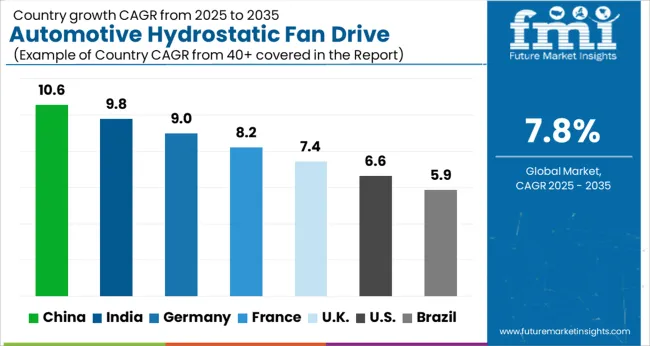
| Countries | CAGR |
|---|---|
| China | 10.6% |
| India | 9.8% |
| Germany | 9.0% |
| France | 8.2% |
| UK | 7.4% |
| USA | 6.6% |
| Brazil | 5.9% |
The Automotive Hydrostatic Fan Drive System Market is expected to register a CAGR of 7.8% during the forecast period, exhibiting varied country level momentum. China leads with the highest CAGR of 10.6%, followed by India at 9.8%. Developed markets such as Germany, France, and the UK continue to expand steadily, while the USA is likely to grow at consistent rates. Brazil posts the lowest CAGR at 5.9%, yet still underscores a broadly positive trajectory for the global Automotive Hydrostatic Fan Drive System Market. In 2024, Germany held a dominant revenue in the Western Europe market and is expected to grow with a CAGR of 9.0%.
The USA Automotive Hydrostatic Fan Drive System Market is estimated to be valued at USD 3.9 billion in 2025 and is anticipated to reach a valuation of USD 7.4 billion by 2035. Sales are projected to rise at a CAGR of 6.6% over the forecast period between 2025 and 2035. While Japan and South Korea markets are estimated to be valued at USD 596.0 million and USD 373.6 million respectively in 2025.
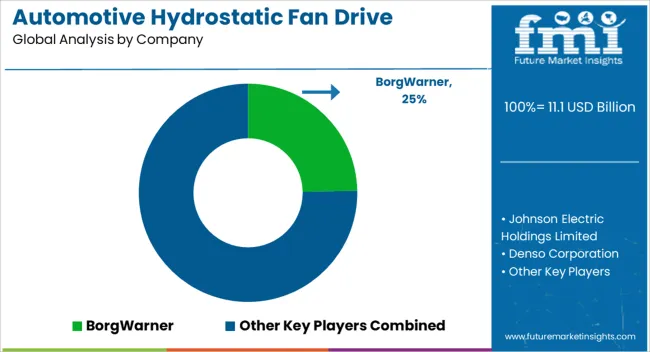
| Item | Value |
|---|---|
| Quantitative Units | USD 11.1 Billion |
| Type of Vehicle | On Road Vehicles, Off Road Vehicles, Construction & Mining Equipment, Agricultural Vehicles, and Train, Metro, and Trams |
| Component | Engine Control Unit (ECU), Variable Axial Piston Hydraulic Pump, Fixed Gear Hydraulic Motor, Hydraulic Valves & Sensors, and Oil Cooler |
| Pump Type | Variable Displacement Pump and Fixed Displacement Pump |
| Regions Covered | North America, Europe, Asia-Pacific, Latin America, Middle East & Africa |
| Country Covered | United States, Canada, Germany, France, United Kingdom, China, Japan, India, Brazil, South Africa |
| Key Companies Profiled | BorgWarner, Johnson Electric Holdings Limited, Denso Corporation, ElringKlinger AG, Sanden Holdings Corporation, Kyosan Electric Manufacturing Co. Ltd., Mitsubishi Heavy Industries Ltd., Eaton Corporation, and Nidec Corporation |
The global automotive hydrostatic fan drive system market is estimated to be valued at USD 11.1 billion in 2025.
The market size for the automotive hydrostatic fan drive system market is projected to reach USD 23.6 billion by 2035.
The automotive hydrostatic fan drive system market is expected to grow at a 7.8% CAGR between 2025 and 2035.
The key product types in automotive hydrostatic fan drive system market are on road vehicles, off road vehicles, construction & mining equipment, agricultural vehicles and train, metro, and trams.
In terms of component, engine control unit (ecu) segment to command 33.8% share in the automotive hydrostatic fan drive system market in 2025.






Our Research Products

The "Full Research Suite" delivers actionable market intel, deep dives on markets or technologies, so clients act faster, cut risk, and unlock growth.

The Leaderboard benchmarks and ranks top vendors, classifying them as Established Leaders, Leading Challengers, or Disruptors & Challengers.

Locates where complements amplify value and substitutes erode it, forecasting net impact by horizon

We deliver granular, decision-grade intel: market sizing, 5-year forecasts, pricing, adoption, usage, revenue, and operational KPIs—plus competitor tracking, regulation, and value chains—across 60 countries broadly.

Spot the shifts before they hit your P&L. We track inflection points, adoption curves, pricing moves, and ecosystem plays to show where demand is heading, why it is changing, and what to do next across high-growth markets and disruptive tech

Real-time reads of user behavior. We track shifting priorities, perceptions of today’s and next-gen services, and provider experience, then pace how fast tech moves from trial to adoption, blending buyer, consumer, and channel inputs with social signals (#WhySwitch, #UX).

Partner with our analyst team to build a custom report designed around your business priorities. From analysing market trends to assessing competitors or crafting bespoke datasets, we tailor insights to your needs.
Supplier Intelligence
Discovery & Profiling
Capacity & Footprint
Performance & Risk
Compliance & Governance
Commercial Readiness
Who Supplies Whom
Scorecards & Shortlists
Playbooks & Docs
Category Intelligence
Definition & Scope
Demand & Use Cases
Cost Drivers
Market Structure
Supply Chain Map
Trade & Policy
Operating Norms
Deliverables
Buyer Intelligence
Account Basics
Spend & Scope
Procurement Model
Vendor Requirements
Terms & Policies
Entry Strategy
Pain Points & Triggers
Outputs
Pricing Analysis
Benchmarks
Trends
Should-Cost
Indexation
Landed Cost
Commercial Terms
Deliverables
Brand Analysis
Positioning & Value Prop
Share & Presence
Customer Evidence
Go-to-Market
Digital & Reputation
Compliance & Trust
KPIs & Gaps
Outputs
Full Research Suite comprises of:
Market outlook & trends analysis
Interviews & case studies
Strategic recommendations
Vendor profiles & capabilities analysis
5-year forecasts
8 regions and 60+ country-level data splits
Market segment data splits
12 months of continuous data updates
DELIVERED AS:
PDF EXCEL ONLINE
ADAS Market Growth - Trends & Forecast 2025 to 2035
Automotive Fan Clutch Market
Automotive Driveshaft Couplings Market
Automotive Brake System Market Growth - Trends & Forecast 2025 to 2035
Automotive Brake System & Components Market Growth - Trends & Forecast 2025 to 2035
Driveline Control Systems and Devices Market Size and Share Forecast Outlook 2025 to 2035
Automotive Piston System Market Growth - Trends & Forecast 2025 to 2035
Driver Monitoring System Market Growth - Trends & Forecast 2025 to 2035
Automotive Washer System Market Trends - Growth & Forecast 2025 to 2035
Automotive Sunroof Drives Market Size and Share Forecast Outlook 2025 to 2035
Automotive Seating Systems Market Analysis - Size, Share & Forecast 2025 to 2035
Automotive Exhaust Systems Market Trends - Growth & Forecast 2025 to 2035
Automotive Cooling Fans Market
Automotive Starting System Market Size and Share Forecast Outlook 2025 to 2035
Automotive Ignition Systems Market Size and Share Forecast Outlook 2025 to 2035
Automotive Electric Drivetrain Components Market Size and Share Forecast Outlook 2025 to 2035
Automotive Steering System Market Growth - Trends & Forecast 2025 to 2035
Automotive Embedded System Market Growth - Trends & Forecast 2024 to 2034
Automotive Defogger System Market
Automotive Platooning System Market Size and Share Forecast Outlook 2025 to 2035

Thank you!
You will receive an email from our Business Development Manager. Please be sure to check your SPAM/JUNK folder too.
Chat With
MaRIA